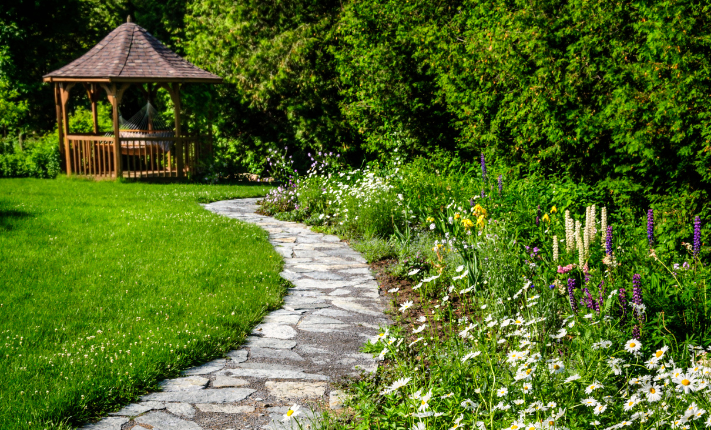Posted by Weatherflow ● August, 2022
How to Rewild Your Garden

The rewilding movement has become a hot topic among gardeners in recent years because of its proven success at increasing biodiversity, improving water quality, and creating self-sustaining ecosystems that require minimal management by using natural resources management techniques.
Rewilding techniques are also becoming very popular in backyard landscapes and front yard gardens to create beautiful and biodiverse havens of native plants, pollinators, and wildlife. Using new age technology and conservation techniques, gardeners of all skill levels can preserve water resources, minimize invasive species, and increase the overall success of their rewilding efforts.
WHAT IS THE REWILDING MOVEMENT?
Rewilding is the idea that a healthy and biodiversity-rich ecosystem can maintain itself without excessive human interference. The rewilding movement aims to promote the protection and restoration of the natural biodiversity of an area, and encourage the growth of important local species. The rewilding movement uses human dedication and new-age technology to create healthy, self-sustaining ecosystems that require as little management as possible.
The rewilding technique is utilized by many groups, from large organizations like international conservation organizations and the United Nations to local and personal level projects. Rewilding can be done on many different scales, all providing crucial enrichment to the immediate environment in and around the rewilded area. With larger-scale restoration projects, there is also a huge potential for increased carbon sequestration and climate change mitigation.
Rewilding techniques can be implemented in a small-scale garden landscape to achieve the same benefits of increased biodiversity, minimized chore load, and decreased dependency on fertilizers and pesticides in local and personal gardens.
IDENTIFYING NATIVE PLANTS
The first step in rewilding your garden is to identify your existing native plant species. Native plants are more likely to survive the conditions of your climate, tend to be less aggressive, and will cater to beneficial predatory insects, migratory birds, and native fauna in your area.
- Encourage the growth of established native species by weeding out undesired species around them and providing accurate amounts of sunlight and moisture according to specific growing needs. You can find out what types of plants and trees are native to your area by using online resources like the Native Plant Finder.
- Consider moving individuals or spreading their seeds into locations more suitable for their preferred growing conditions.
- Local plant nurseries should have native plant options available for purchase.
- Choose flowering species that will bloom from early spring to late fall to give pollinators food throughout the season while also providing plenty of beauty for you to enjoy.
ENCOURAGING BIODIVERSITY
Rewilding a garden is more than just bringing native plant species back into the area. It is also important to increase the biodiversity of beneficial insects, pollinators, migratory birds, and local fauna within your landscape. Using the following Integrated Pest Management (IPM) techniques will help you to control the pests in your rewilded garden without using chemical pesticides.
- Adding decretive log piles, rock quarries, and specialized bee boxes while leaving some plant residue in the fall will encourage beneficial predatory insects and pollinators to nest in your area.
- Minimizing the number of borders and barriers is essential when rewilding your garden. Try to instead create passageways for wildlife to migrate through.
- If deer become a problem, you can plant deer-resistant hedges, such as boxwood, juniper, and currants, that redirect them away from a specific garden area without limiting their ability to migrate freely.
WATER CONSERVATION
Rewilding your garden also encourages you to concentrate on water conservation by planting drought-tolerant species and limiting your watering needs based on specific species and climate.
- Technology such as the Tempest Weather System can help gardeners to know exactly how much water is needed based on their specific microclimate and weather forecast. Save time and money with Tempest smart home integrations like our Rachio Smart Sprinkler integration, freeze and frost notifications, and more.
- Soil conservation through low or no-till practices and mulching can greatly increase water availability to your plants. Allowing the grass to grow longer between mowing sessions will encourage the growth of deep roots that hold soil and conserve water.
- Or ditch mowing altogether by transforming your large lawn or field into a wildflower meadow with native plant species that use less water, and don’t require fertilizer or pruning. Plant native legume species such as lupines, indigos, and wild pea species to attract local wildlife and help restore the soil with Nitrogen.
CONCLUSION
The rewilding movement is the idea that a healthy ecosystem rich in biodiversity can maintain itself without the consistent need for maintenance and interference by humans. Rewilding techniques promote creating space for wildlife inhabitation, nurturing native biodiversity, and encouraging the growth of important local species of plants, insects, and other forms of wildlife.
The rewilding movement has shown recorded success using natural management techniques such as planting native species, Integrated Pest Management, and soil conservation. The benefits of rewilding your garden include increasing native flora and fauna, improving water quality, and creating beautiful self-sustaining ecosystems that require minimal management.
It’s no wonder why the rewilding movement and techniques are becoming very popular to implement in backyard landscapes and front yard gardens. With a little dedication, choosing to rewild your garden to create beautiful, biodiverse havens of native plants, pollinators, birds, and wildlife will be easy thanks to new age technology and tested conservation techniques.

